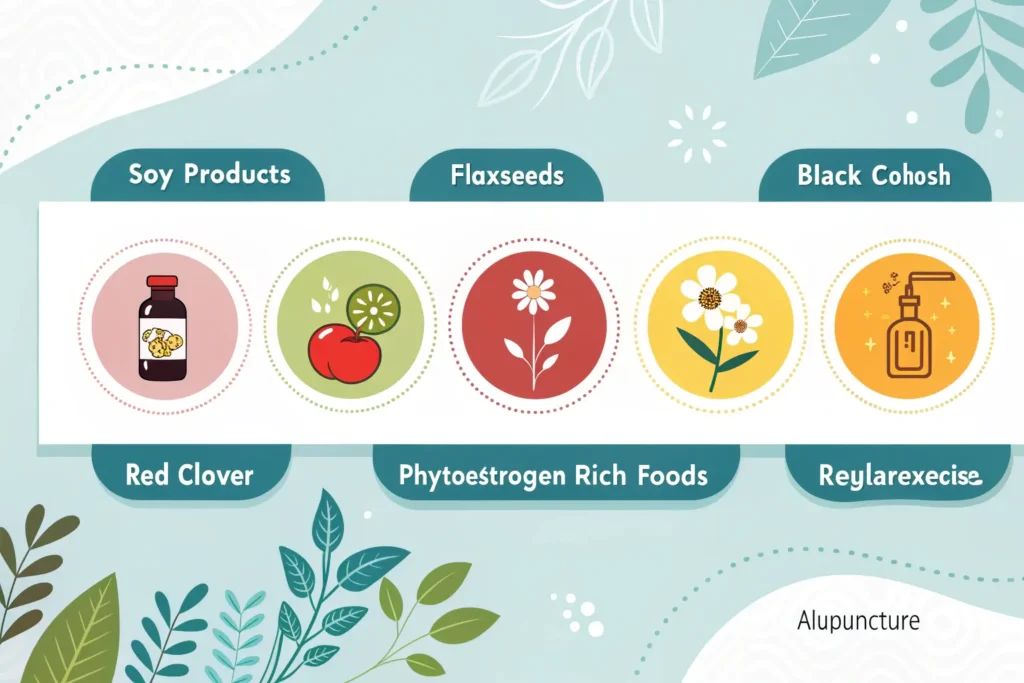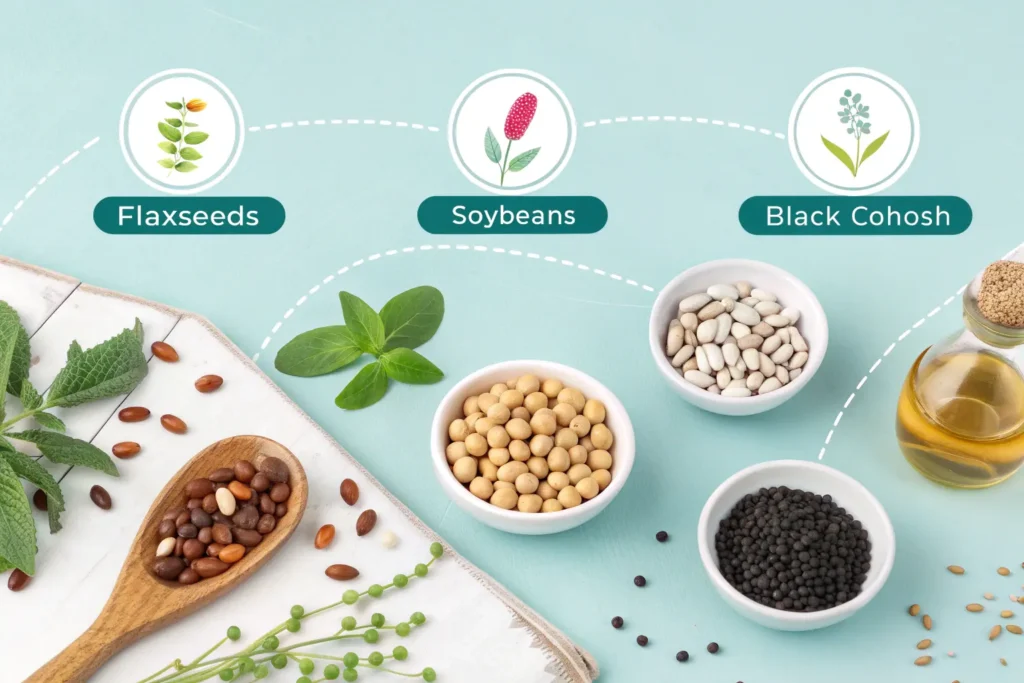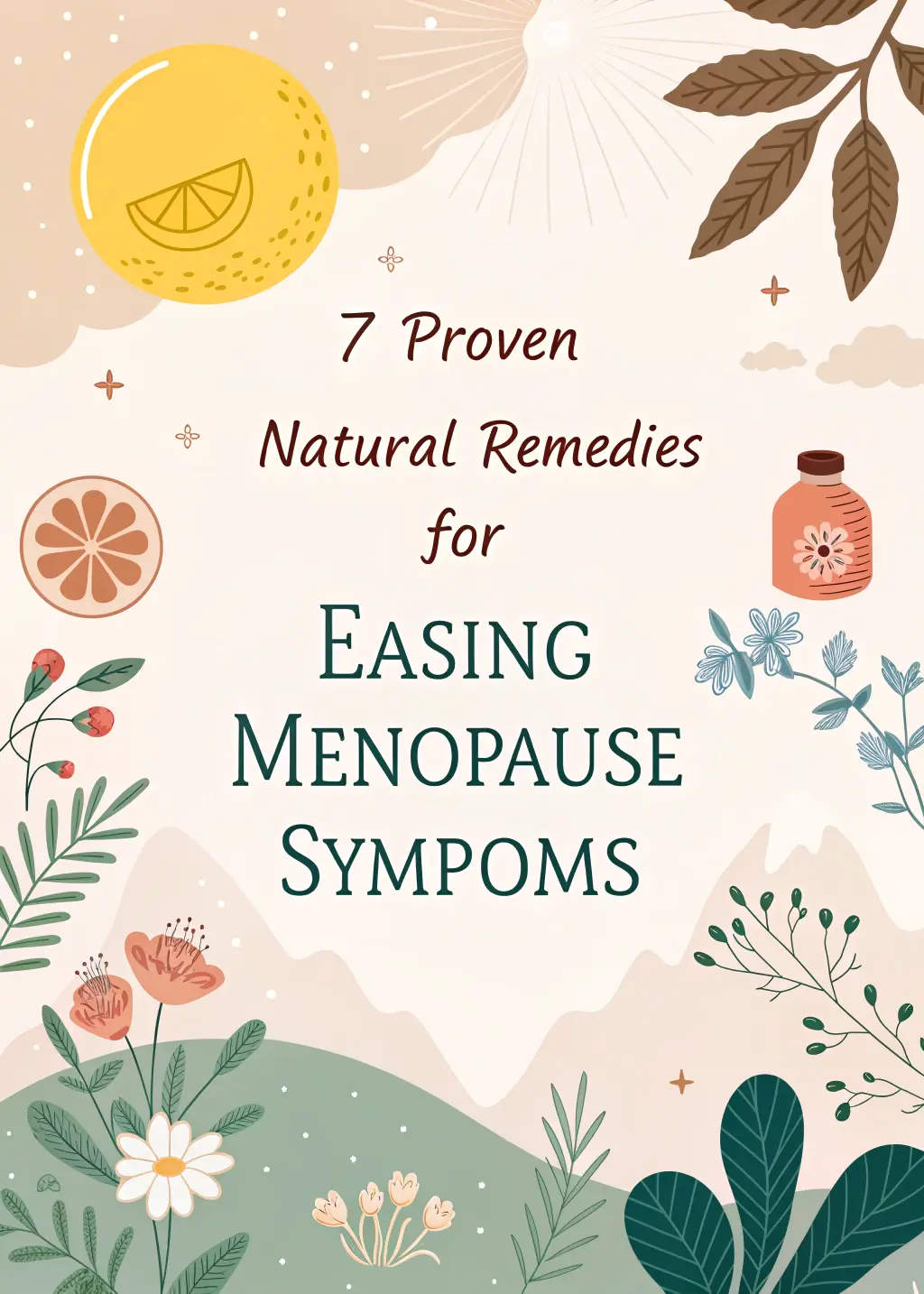Menopause is a natural transition that every woman experiences, typically occurring between ages 45-55. While it marks the end of reproductive years, it can bring challenging symptoms like hot flashes, night sweats, mood changes, sleep disturbances, and vaginal dryness. The good news is that numerous natural remedies have been studied and shown to provide significant relief for these symptoms.
If you’re looking for alternatives to hormone replacement therapy or want to complement your current treatment plan, these seven evidence-based natural remedies can help you navigate menopause more comfortably.
Table of Contents
1. Black Cohosh: The Hot Flash Fighter
Black cohosh (Actaea racemosa) is one of the most extensively studied herbs for menopause relief. This North American plant has been used traditionally for women’s health issues for centuries, and modern research supports its effectiveness.
How it works: Black cohosh appears to interact with serotonin receptors in the brain, which may help regulate body temperature and mood. It doesn’t contain plant estrogens but may help modulate the body’s response to declining estrogen levels.
The evidence: Multiple studies have shown that black cohosh can reduce the frequency and intensity of hot flashes by up to 50%. A 2016 review of clinical trials found it particularly effective for hot flashes and night sweats, with benefits typically appearing after 4-8 weeks of use.
How to use: The standard dose is 40-80mg daily of standardized extract. Look for products standardized to triterpene glycosides, the active compounds. Start with a lower dose and gradually increase as needed.

2. Red Clover: Nature’s Phytoestrogen Powerhouse
Red clover (Trifolium pratense) contains high levels of isoflavones, plant compounds that have mild estrogenic effects. These phytoestrogens can help fill the gap left by declining natural estrogen production.
How it works: The isoflavones in red clover, particularly genistein and daidzein, can bind to estrogen receptors in the body and provide gentle estrogenic activity. This may help reduce hot flashes and support bone health.
The evidence: Studies have shown that red clover can reduce hot flash frequency by 30-50% and may also help maintain bone density. A 2015 systematic review found significant improvements in menopausal symptoms with red clover supplementation.
How to use: Typical doses range from 80-120mg daily of standardized extract containing 8-12% isoflavones. Red clover can also be consumed as tea, though the concentration of active compounds is lower.
3. Evening Primrose Oil: Hormonal Balance Support
Evening primrose oil (EPO) is rich in gamma-linolenic acid (GLA), an omega-6 fatty acid that plays important roles in hormone production and inflammation regulation.
How it works: GLA helps produce prostaglandins that regulate inflammation and hormone function. This can help stabilize mood, reduce breast tenderness, and may help with temperature regulation.
The evidence: Research shows evening primrose oil can help reduce hot flash severity and frequency. A 2013 study found that women taking EPO experienced significant improvements in hot flash intensity and daily life disruption compared to placebo.
How to use: The typical dose is 1-3 grams daily, usually divided into two doses with meals. Choose cold-pressed, high-quality oil and look for products that provide at least 8-10% GLA.
4. Sage: The Cooling Herb
Sage (Salvia officinalis) has been used traditionally to reduce excessive sweating and has gained attention for its potential in managing hot flashes and night sweats.
How it works: Sage contains compounds that may help regulate the sympathetic nervous system, which controls sweating and temperature regulation. It also has mild estrogenic properties that may contribute to its effectiveness.
The evidence: A 2011 study found that fresh sage leaf extract reduced hot flash frequency by 50% within four weeks, with even greater improvements at eight weeks. Participants also reported better sleep quality and reduced night sweats.
How to use: Sage can be taken as a standardized extract (280-400mg daily), consumed as tea (1-2 cups daily), or used as a tincture. For tea, steep 1-2 teaspoons of dried sage in hot water for 10-15 minutes.
5. Maca Root: The Adaptogenic Hormone Balancer
Maca (Lepidium meyenii) is a Peruvian root vegetable that has been used for centuries to support hormonal health and energy levels. It’s classified as an adaptogen, helping the body adapt to stress and hormonal changes.
How it works: Rather than containing hormones, maca appears to support the hypothalamic-pituitary-adrenal axis, which regulates hormone production. This can help the body better adapt to the hormonal changes of menopause.
The evidence: Studies have shown that maca can reduce menopausal symptoms including hot flashes, night sweats, and mood disturbances. A 2008 study found significant improvements in menopausal symptoms and quality of life after just six weeks of maca supplementation.
How to use: Start with 1-2 grams daily and gradually increase to 3-6 grams if needed. Maca powder can be mixed into smoothies, oatmeal, or yogurt. Gelatinized maca is easier to digest than raw maca powder.
6. Dong Quai: The Female Ginseng
Dong quai (Angelica sinensis) has been called “female ginseng” in Traditional Chinese Medicine, where it’s been used for over 2,000 years to support women’s health throughout all life stages.
How it works: Dong quai contains compounds that may help regulate estrogen activity and support healthy circulation. It also has mild sedative properties that can help with sleep and mood issues.
The evidence: While research is mixed when dong quai is used alone, it shows promise when combined with other herbs. Studies of dong quai in herbal formulations have shown improvements in hot flashes, mood, and overall quality of life during menopause.
How to use: Dong quai is typically taken as a standardized extract (500-600mg daily) or as part of a comprehensive herbal formula. It can also be consumed as tea, though the taste is quite bitter.
7. Mindfulness and Stress Reduction Techniques
While not an herb or supplement, mindfulness-based stress reduction (MBSR) and other stress management techniques have shown remarkable effectiveness in managing menopause symptoms.
How it works: Stress can worsen menopause symptoms by disrupting the hypothalamic-pituitary-adrenal axis and affecting neurotransmitter balance. Mindfulness practices help regulate the stress response and may influence how the body experiences symptoms like hot flashes.
The evidence: A 2011 study found that women who practiced mindfulness-based stress reduction experienced significant reductions in hot flash bother and sleep disturbances. Other studies have shown that regular meditation can reduce the frequency and intensity of hot flashes by up to 40%.
How to practice: Start with just 10-15 minutes of daily meditation, deep breathing exercises, or gentle yoga. Apps like Headspace or Calm can provide guided sessions. Progressive muscle relaxation and visualization techniques are also effective.

Creating Your Natural Menopause Support Plan
When implementing these natural remedies, keep these important points in mind:
Start gradually: Begin with one or two remedies and give them at least 6-8 weeks to show effects. Hormonal changes take time, and your body needs time to respond to natural interventions.
Quality matters: Choose high-quality, standardized extracts from reputable manufacturers. Look for third-party testing and proper certifications.
Track your symptoms: Keep a symptom diary to monitor which remedies are most effective for your specific symptoms. Note frequency, intensity, and timing of symptoms.
Be consistent: Natural remedies work best when used consistently. Set up a routine that you can maintain long-term.
Combine approaches: Many women find that combining several natural remedies provides better results than using just one. Consider pairing herbs with lifestyle changes like stress reduction and dietary modifications.
Safety Considerations and When to Consult Your Healthcare Provider
While these natural remedies are generally safe for most women, it’s important to:
- Consult with a healthcare provider before starting any new supplement regimen, especially if you’re taking medications or have health conditions
- Be aware that some herbs can interact with medications, particularly blood thinners and diabetes medications
- Start with lower doses and gradually increase as needed
- Stop use and consult a healthcare provider if you experience any adverse effects
Seek professional guidance if you experience severe symptoms such as heavy bleeding, severe mood changes, or symptoms that significantly impact your quality of life.
Embracing Your Natural Transition
Menopause is a natural life transition that doesn’t have to be endured with suffering. These seven proven natural remedies offer safe, effective options for managing symptoms and supporting your body through this change. Remember that every woman’s experience is unique, and what works best for you may take some experimentation to discover.
By combining these natural approaches with healthy lifestyle habits like regular exercise, stress management, and a nutritious diet, you can navigate menopause with greater comfort and confidence. The key is to be patient, consistent, and kind to yourself as you explore these natural solutions for this important life transition.





